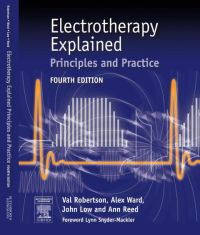Electrotherapy Explained is an excellent research-based exploration of the major types of electrophysical agents used in clinical practice, particularly human and also animal. For the fourth edition, two new authors join the writing team, presenting the latest information for today's clinicians. The text has been completely updated with a major rewrite of the material, particularly that on electrical stimulation. This book continues to focus on evidence: clinical and biophysical evidence that affects how and which electrotherapies may be of use clinically and when. The inclusion of biophysics as well as clinical evidence and principles of application, enables clinicians to move away from traditional ‘recipe-based' approaches and rely more on their own clinical reasoning. The focus remains on humans but the relevance of the principles for using and applying different modalities is explained clearly, providing guidelines for clinicians across disciplines and specialties.
Key Features
Author Information
By Val Robertson, PhD, Professor, University of Newcastle, Australia; Alex Ward, PhD, Senior Lecturer, Department of Human Physiology and Anatomy; La Trobe University, Australia; John Low, BA(Hons), FCSP, DipTP, Formerly Acting Principal, School of Physiotherapy, Guy's Hospital, London, UK and Ann Reed, BA, MCSP, DipTP, Formerly Senior lecturer, Department of Health Sciences, University of East London, UK
1. Introduction2. Background Biophysics And Physiology3. Electrical Stimulation - Currents And Parameters4. Effects Of Electrical Stimulation5. Motor Electrical Stimulation6. Sensory Stimulation And Other Uses7. Risk Management8. Biofeedback9. Ultrasound10. Heat And Cold11. Therapeutic Conduction Heating12. Cold Therapy13. Electromagnetic Fields: Shortwave14. Electromagnetic Radiation15. Microwave Diathermy16. Infrared And Visible Radiation17. Ultraviolet RadiationAppendix
This text has new lead authors who are well published in 'electrotheraphy'. The focus is on biophysics and physiology that underpin use of electrophysical agents (EPAs) - and the text lives up to its title. I would highly reccomend this title for students.Physical Therapy Reviews, December 2006An excellent text for professional clinical education programs, especially if principles and application of evidence-based practice is a focus of the curriculum. This text would be an excellent resource not just for the beginning clinician but for anyone looking to either expand or update their knowledge on the subject. Finally, the book is accompanied with a CD-ROM [now on website - http://booksite.elsevier.com/9780750688437] includes the full text of 2 additional books: Physical Principles Explained by Low and Reed and Biophysical Basis of Electrotherapy by Ward. The inclusion of the CD [website] makes this text an even richer source for the best information concerning therapeutic modalities.Physical Therapy Volume 87 Number 8 August 2007


